
Concept explainers
(a)
Interpretation:
The phases present in the phase diagrams have to be stated.
Concept introduction:
The azeotropic mixture is defined as a mixture of two or more liquids which evaporates without altering the composition of the mixture. The azeotropic mixture has a constant boiling point because of the same composition in liquid as well as vapor phase. The components of azeotropic mixture are not separated by distillation processes.
The phase diagram represents the changes in the mixture on changing the parameters like temperature and pressure of the mixture.
(a)
Answer to Problem 5C.5P
The phases have been stated in the phase diagrams as,
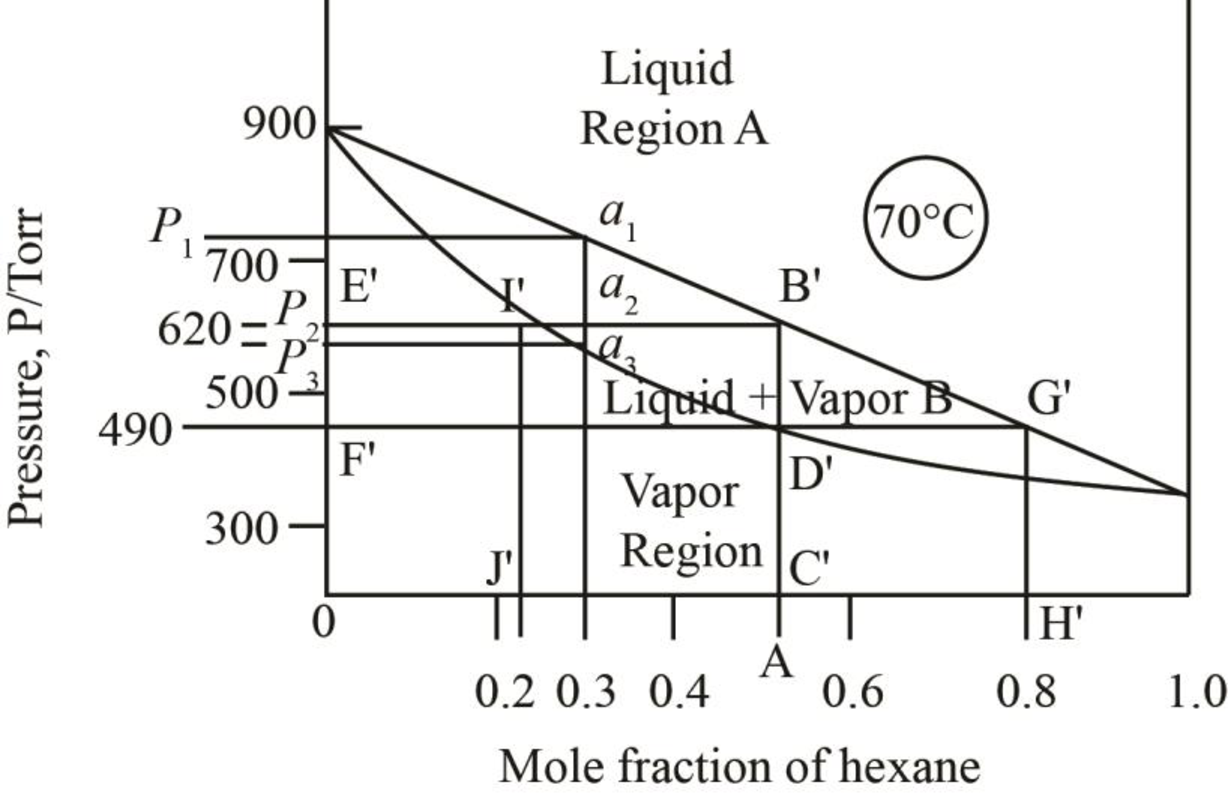
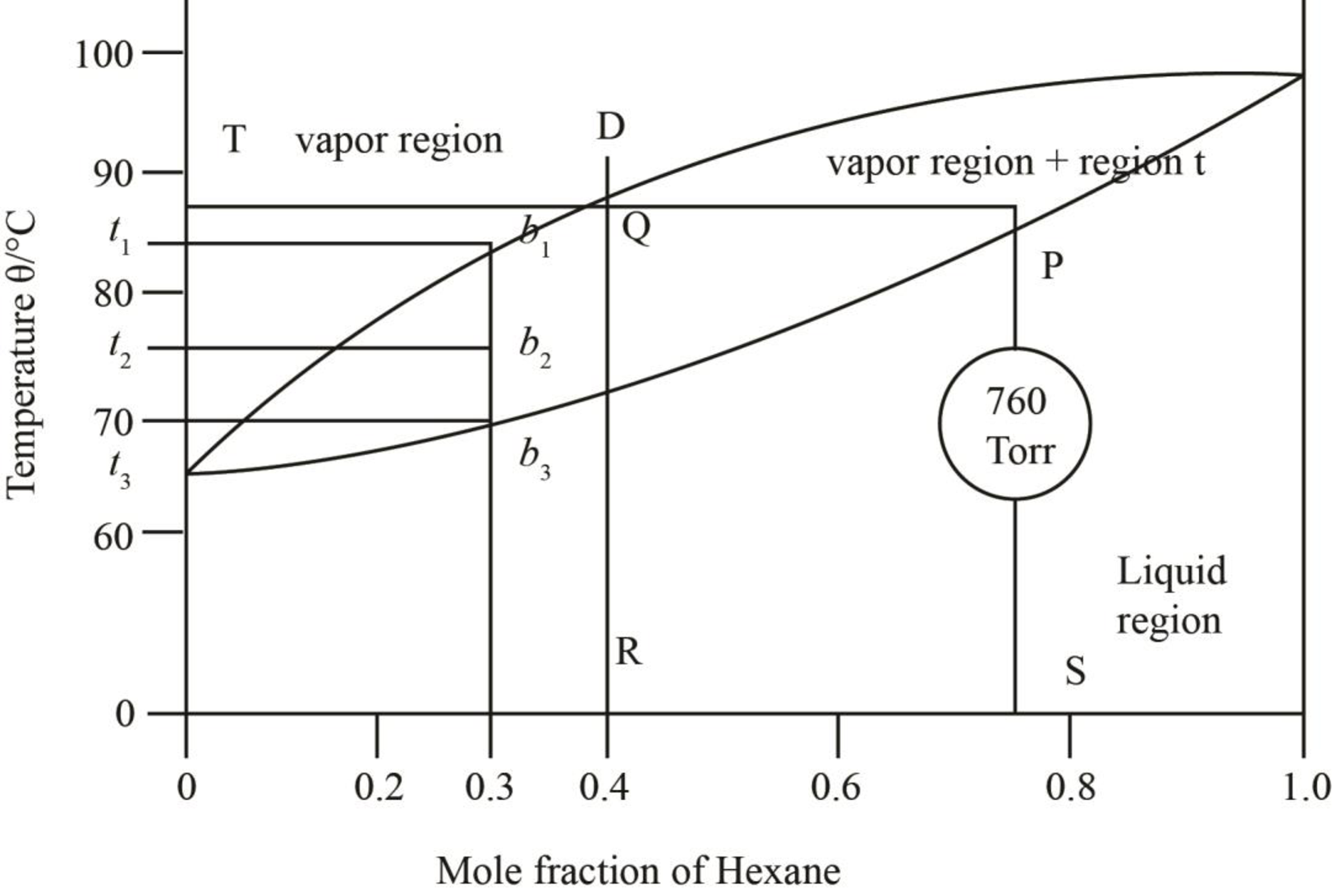
Explanation of Solution
The given phase diagrams are shown below as,
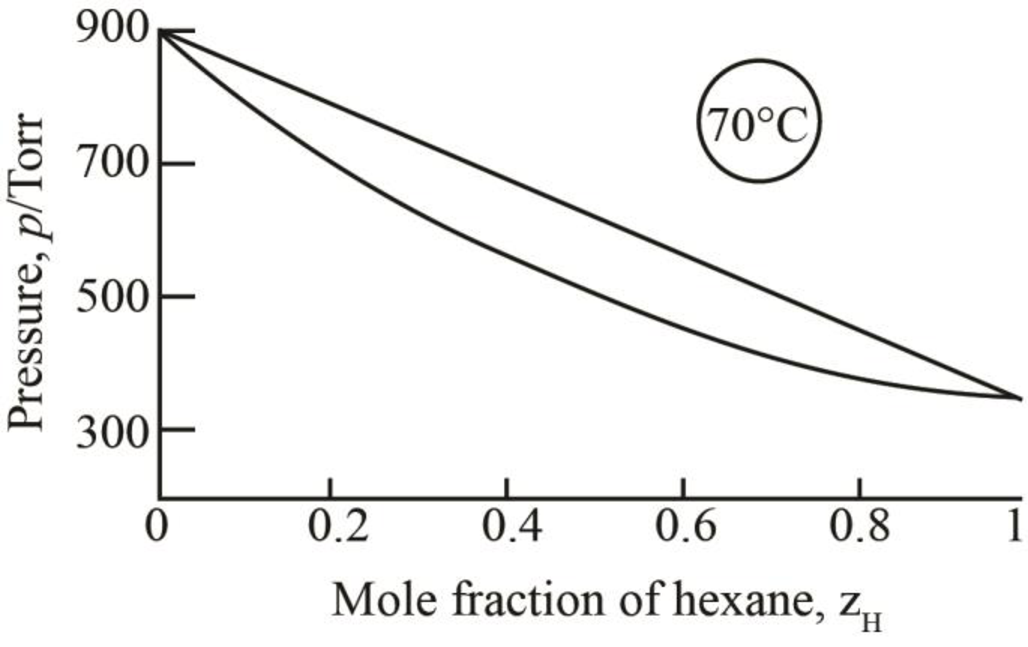
Figure 1
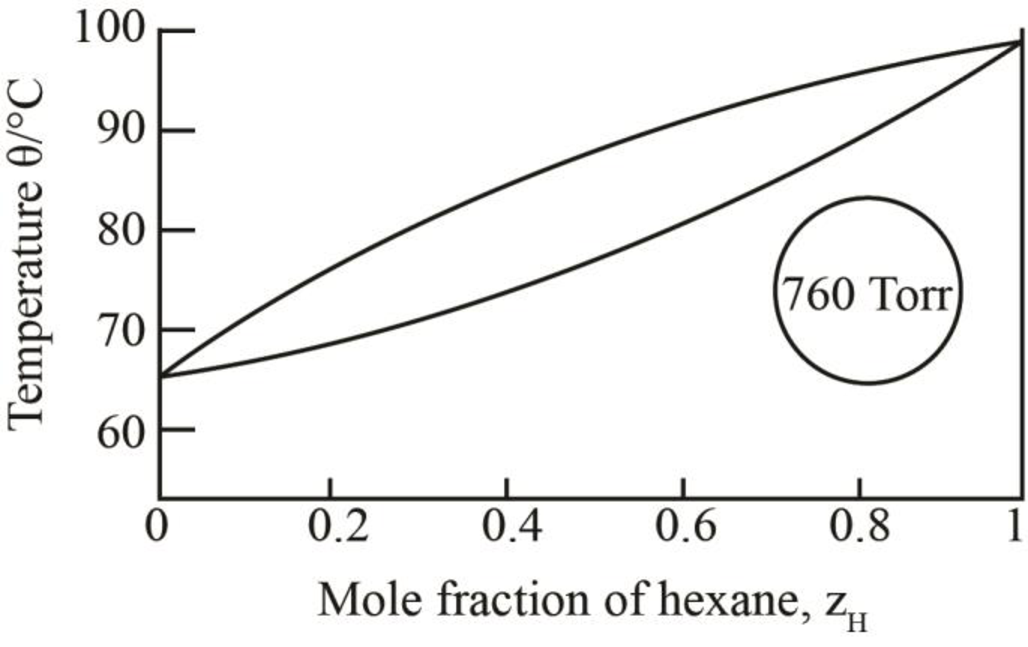
Figure 2
The region between the liquid phase curve and vapour phase curve has liquid and vapour phase in the equilibrium. Thus, the number of phases present in that region is
In the region above the curve, only vapour phase is present.
In the region below the curve, only liquid phase is present.
The regions are stated in the phase diagrams as,
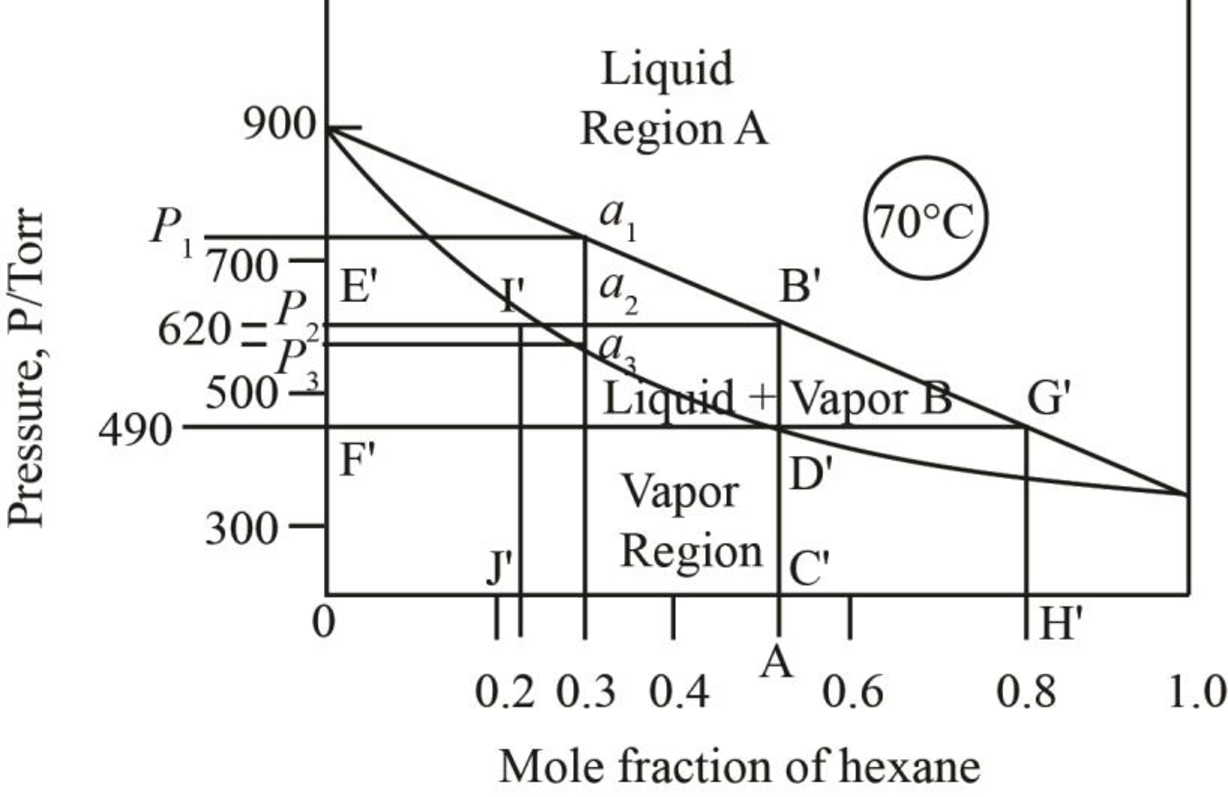
Figure 3
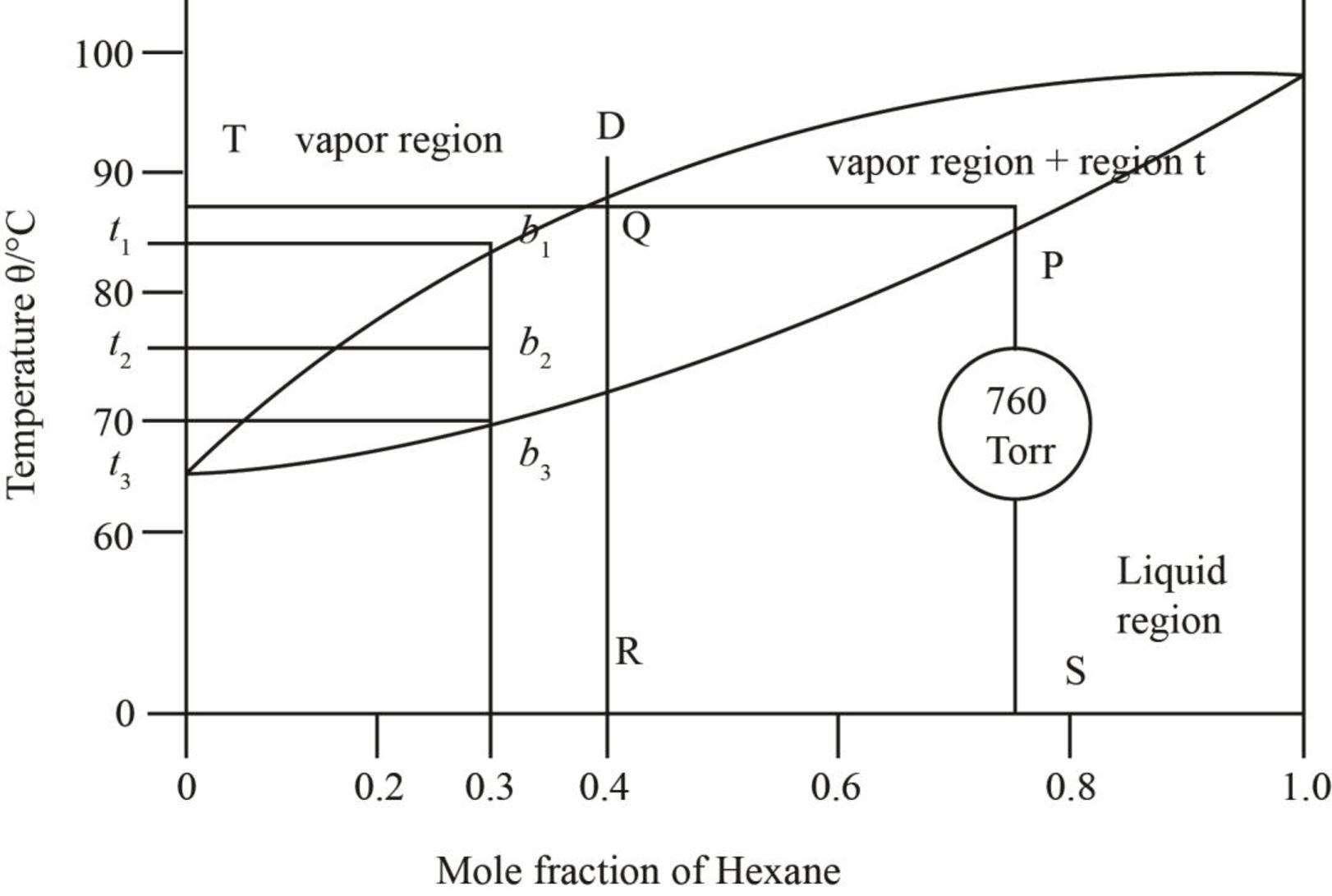
Figure 4
(b)
Interpretation:
The vapor pressure of the mixture of heptane and hexane at
Concept introduction:
The azeotropic mixture is defined as a mixture of two or more liquids which evaporates without altering the composition of the mixture. The azeotropic mixture has a constant boiling point because of the same composition in liquid as well as vapor phase. The components of azeotropic mixture are not separated by distillation processes.
The phase diagram represents the changes in the mixture on changing the parameters like temperature and pressure of the mixture.
(b)
Answer to Problem 5C.5P
The vapour pressure of the mixture of heptane and hexane at
Explanation of Solution
The number of moles of heptane and hexane present in the mixture is
The mole fraction is calculated by the formula as,
The total number of moles of the mixture is calculated as,
Substitute the values in the equation (1) to calculate the mole fraction of hexane as,
The pressure corresponding to
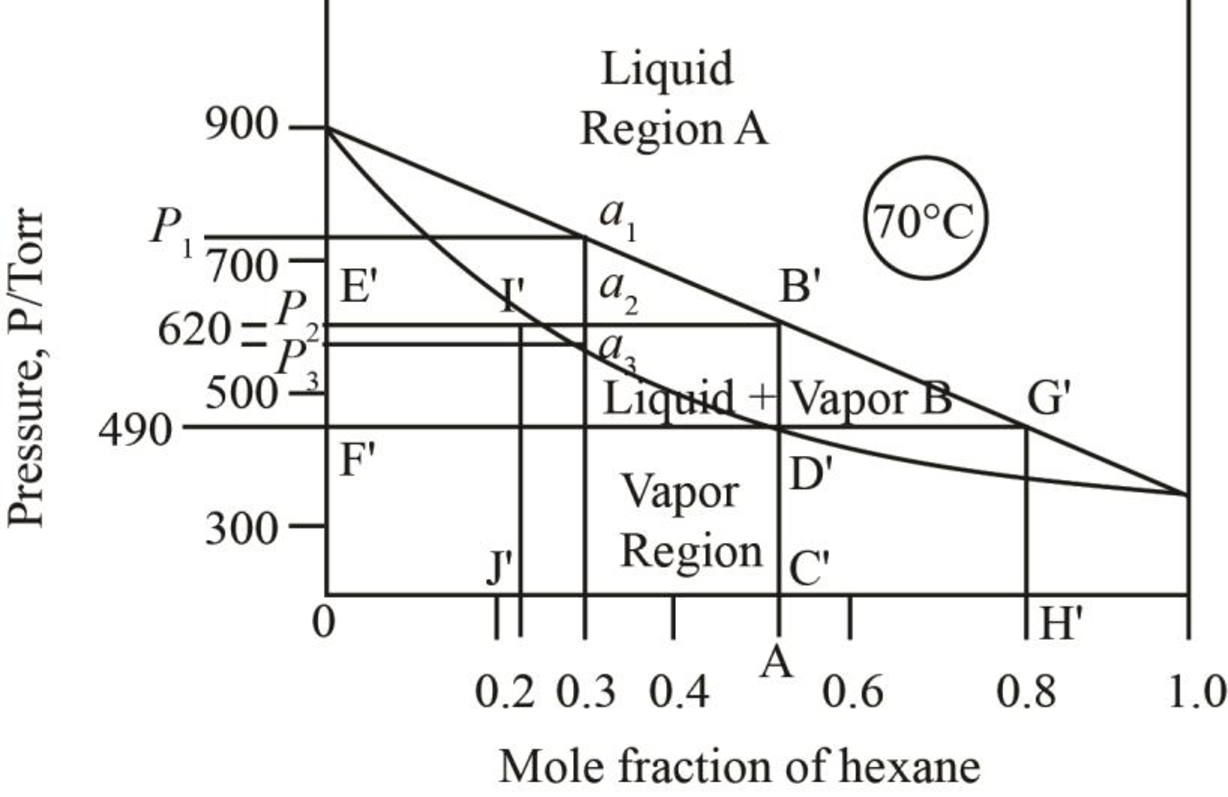
Figure 5
Thus, the vapour pressure of the mixture of heptane and hexane at
(c)
Interpretation:
The vapor pressure of the mixture of heptane and hexane at
Concept introduction:
The azeotropic mixture is defined as a mixture of two or more liquids which evaporates without altering the composition of the mixture. The azeotropic mixture has a constant boiling point because of the same composition in liquid as well as vapor phase. The components of azeotropic mixture are not separated by distillation processes.
The phase diagram represents the changes in the mixture on changing the parameters like temperature and pressure of the mixture.
(c)
Answer to Problem 5C.5P
The vapour pressure of the mixture of heptane and hexane at
Explanation of Solution
The number of moles of heptane and hexane present in the mixture is
The mole fraction is calculated by the formula as,
The total number of moles of the mixture is calculated as,
Substitute the values in the equation (1) to calculate the mole fraction of hexane as,
The pressure corresponding to
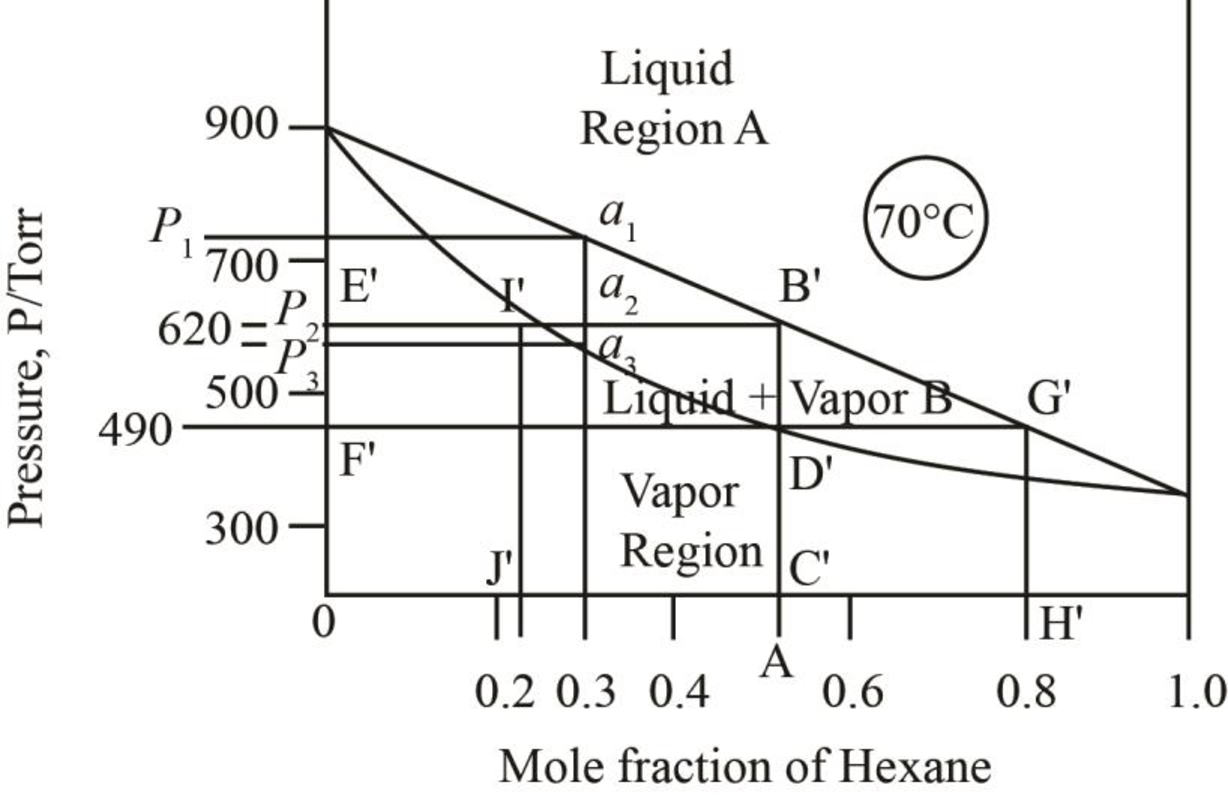
Figure 6
When just one drop of the liquid remains, then the vapour pressure of the mixture is more than
Thus, the vapour pressure of the mixture of heptane and hexane at
(d)
Interpretation:
The mole fraction of hexane in the liquid and vapour phase for the conditions of part b has to be calculated.
Concept introduction:
The azeotropic mixture is defined as a mixture of two or more liquids which evaporates without altering the composition of the mixture. The azeotropic mixture has a constant boiling point because of the same composition in liquid as well as vapor phase. The components of azeotropic mixture are not separated by distillation processes.
The phase diagram represents the changes in the mixture on changing the parameters like temperature and pressure of the mixture.
(d)
Answer to Problem 5C.5P
The mole fraction of hexane in the liquid and vapour phase for the conditions of part b has been calculated as
Explanation of Solution
The number of moles of hexane present in the mixture is given as
The mole fraction is calculated by the formula as,
The total number of moles of the mixture is calculated as,
Substitute the values in the equation (1) to calculate the mole fraction of hexane as,
The mole fraction of hexane in the liquid phase is taken by drawing the line on the liquid curve of the phase diagram which is shown by the line AB’ in phase diagram below.
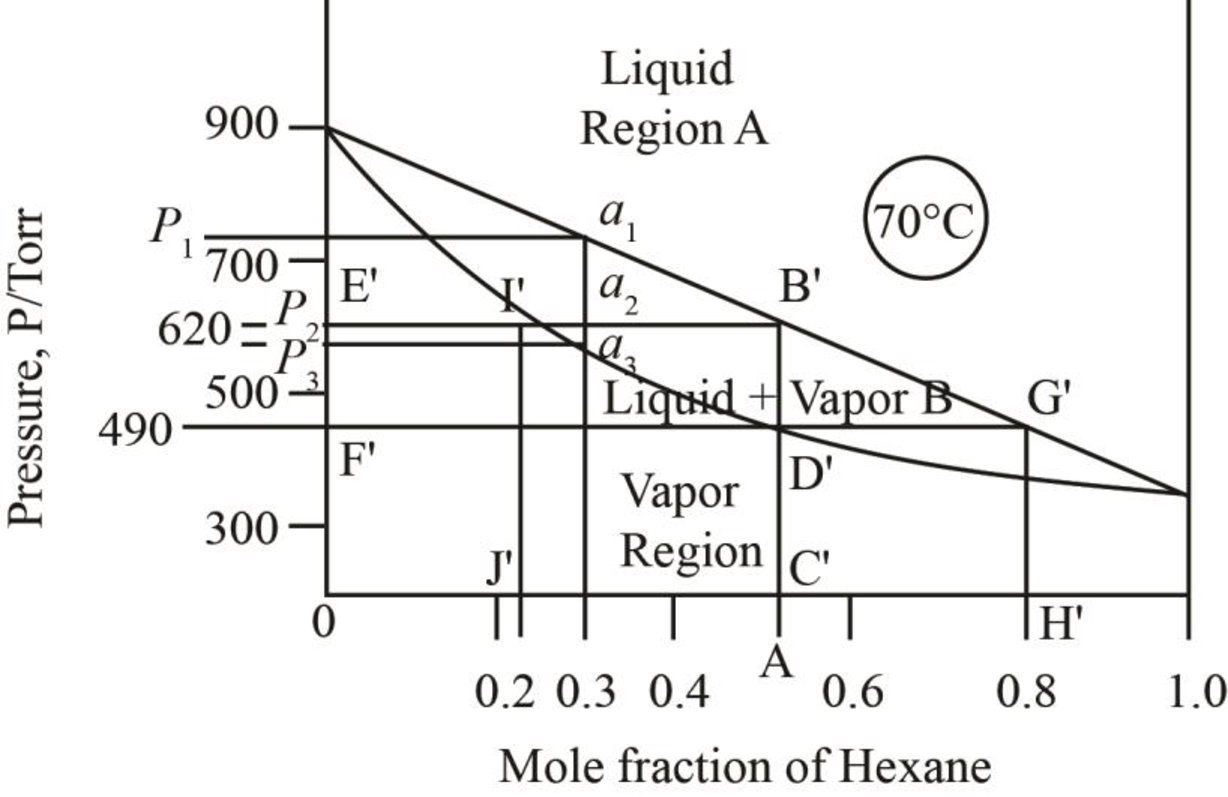
Figure 7
Thus, mole fraction of hexane in the liquid and vapour phase for the conditions of part b is
(e)
Interpretation:
The mole fraction of hexane in the liquid and vapour phase for the conditions of part c has to be calculated.
Concept introduction:
The azeotropic mixture is defined as a mixture of two or more liquids which evaporates without altering the composition of the mixture. The azeotropic mixture has a constant boiling point because of the same composition in liquid as well as vapor phase. The components of azeotropic mixture are not separated by distillation processes.
The phase diagram represents the changes in the mixture on changing the parameters like temperature and pressure of the mixture.
(e)
Answer to Problem 5C.5P
The mole fraction of hexane in the liquid and vapour phase for the conditions of part c has been calculated as
Explanation of Solution
The number of moles of hexane present in the mixture is given as
The mole fraction is calculated by the formula as,
The total number of moles of the mixture is calculated as,
Substitute the values in the equation (1) to calculate the mole fraction of hexane as,
The mole fraction of hexane in the liquid phase is taken by drawing a parallel line on the liquid curve of the phase diagram which is shown by the line F’G’ in phase diagram below.
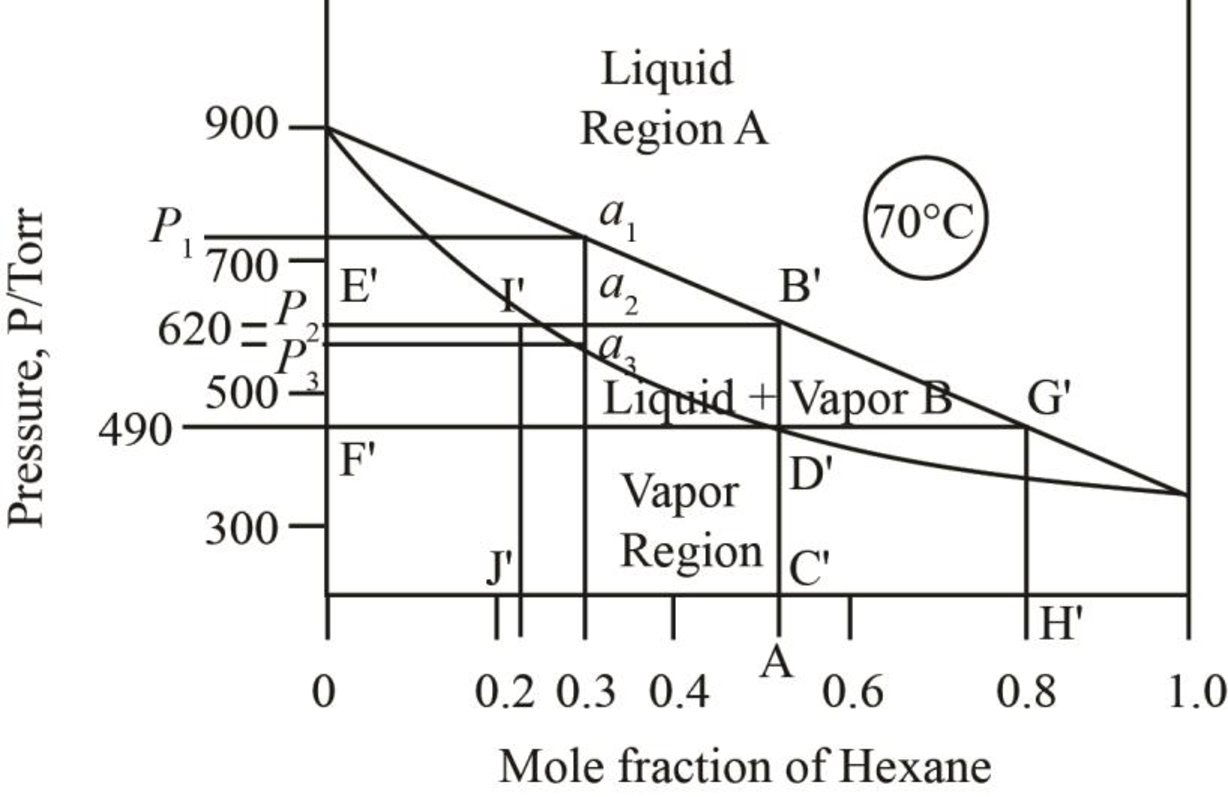
Figure 8
The mole fraction of hexane in the liquid phase is found out to be
Thus, mole fraction of hexane in the liquid and vapour phase for the conditions of part c is
(f)
Interpretation:
The amounts of substances in the liquid and vapour phase at
Concept introduction:
The azeotropic mixture is defined as a mixture of two or more liquids which evaporates without altering the composition of the mixture. The azeotropic mixture has a constant boiling point because of the same composition in liquid as well as vapor phase. The components of azeotropic mixture are not separated by distillation processes.
The phase diagram represents the changes in the mixture on changing the parameters like temperature and pressure of the mixture.
(f)
Answer to Problem 5C.5P
The mole fraction of hexane in the liquid and vapour phase at
Explanation of Solution
The overall mole fraction of heptane present in the mixture is given as
Thus, the overall mole fraction of hexane present in the mixture is calculated as,
The mole fraction of hexane in the liquid phase is taken by drawing a line passing through
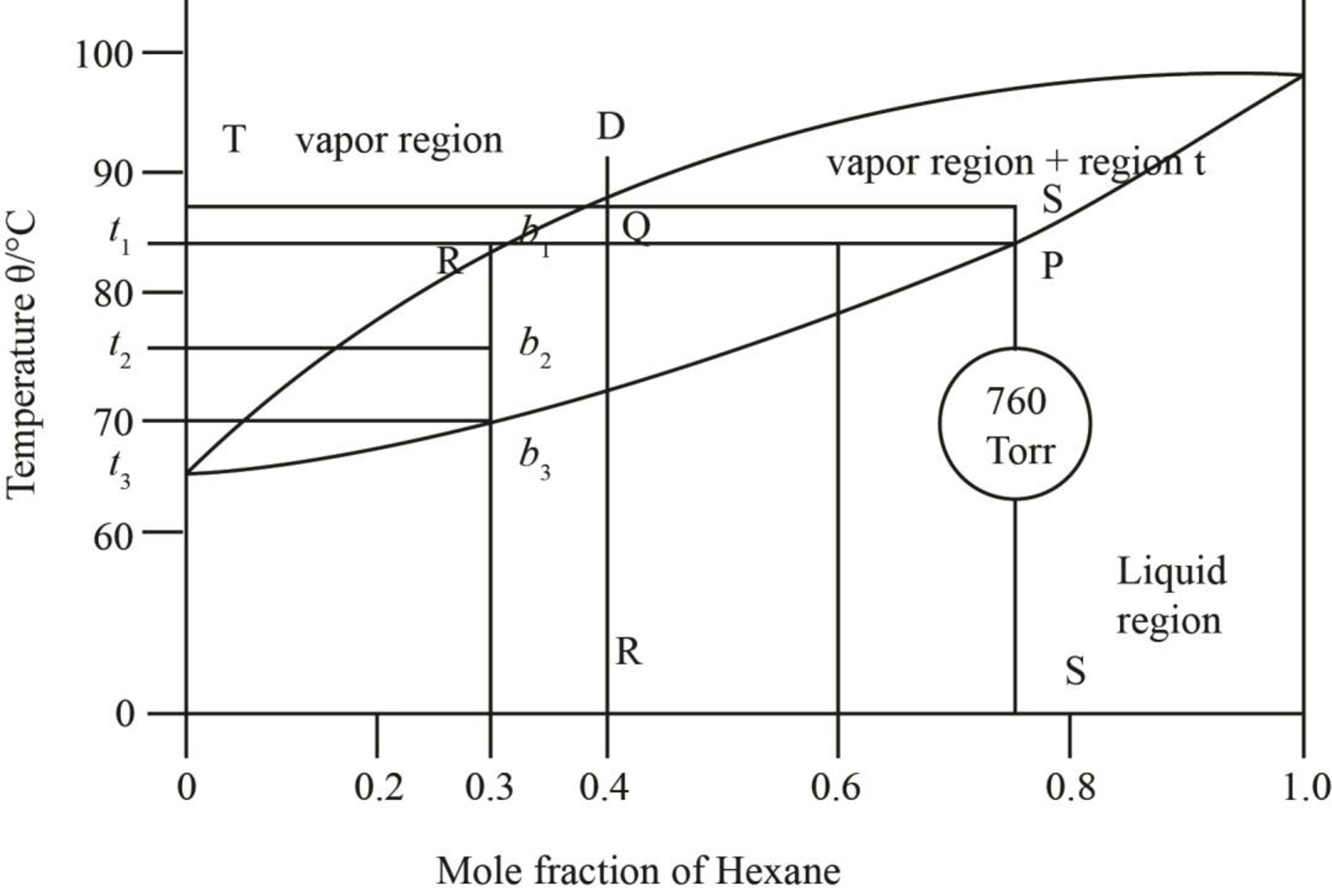
Figure 9
The mole fraction of hexane in the liquid phase is found out to be approximately
Thus, the mole fraction of heptane in the liquid phase is calculated as,
The mole fraction of hexane in the vapour phase is found out to be
Thus, the mole fraction of heptane in the vapour phase is calculated as,
Thus, mole fraction of hexane in the liquid and vapour phase at
Want to see more full solutions like this?
Chapter 5 Solutions
ATKINS' PHYSICAL CHEMISTRY
- What is the major enolate formed when treated with LDA? And why that one?arrow_forward4. Calculate the total number of sigma bonds and total number of pi bonds in each of the following compounds. a. HH :D: +1 I H-N-C-C-O-H I H b. HH H Н :N=C-C-C=C-CEC-H :0: total o H-C-H H-C = `C-H I H. 11 H-C = C= CH H total o total π total π 1 Harrow_forwardIn the following reaction, what quantity in moles of CH₃OH are required to give off 4111 kJ of heat? 2 CH₃OH (l) + 3 O₂ (g) → 2 CO₂ (g) + 4 H₂O(g) ∆H° = -1280. kJarrow_forward
- Indicate the processes in the dismutation of Cu2O.arrow_forward1. Consider these three reactions as the elementary steps in the mechanism for a chemical reaction. 2600 2400 2200 2000 1800 1600 1400 1200 1000 800 Potential Energy (kJ) 600 400 200 0 -200- -400 -600- -800 (i) Cl₂ (g) + Pt(s) → 2Cl (g) + Pt(s) (ii) Cl (g)+ CO (g) + Pt (s) → CICO (g) + Pt (s) Ea = 1550 kJ Ea = 2240 kJ (iii) Cl (g) + CICO (g) → Cl₂CO (g) Ea = 2350 kJ AH=-950 kJ ΔΗ = 575 ΚΙ AH=-825 kJ a. Draw the potential energy diagram for the reaction. Label the data points for clarity. The potential energy of the reactants is 600 kJ Reaction Progress b. What is the overall chemical equation? c. What is the overall change in enthalpy for the above chemical reaction? d. What is the overall amount of activation energy for the above chemical reaction? e. Which reaction intermediate would be considered a catalyst (if any) and why? f. If you were to add 2700kJ of energy to the reaction (e.g. 2700 kl of heat or electricity), would you be able to make the reaction reverse itself (i.e. have…arrow_forwarddraw the enolate anion and the carbonyl that would be needed to make this product through an aldol addition reaction.arrow_forward
- Draw the Michael Adduct and the final product of the Robinson annulation reaction. Ignore inorganic byproducts.arrow_forwardDraw the Michael adduct and final product of the Robinson annulation reaction. Ignore inorganic byproductsarrow_forwardPost Lab Questions. 1) Draw the mechanism of your Diels-Alder cycloaddition. 2) Only one isomer of product is formed in the Diels-Alder cycloaddition. Why? 3) Imagine that you used isoprene as diene - in that case you don't have to worry about assigning endo vs exo. Draw the "endo" and "exo" products of the Diels-Alder reaction between isoprene and maleic anhydride, and explain why the distinction is irrelevant here. 4) This does not hold for other dienes. Draw the exo and endo products of the reaction of cyclohexadiene with maleic anhydride. Make sure you label your answers properly as endo or exo. 100 °C Xylenes ??? 5) Calculate the process mass intensity for your specific reaction (make sure to use your actual amounts of reagent).arrow_forward
- Indicate the product(s) A, B C and D that are formed in the reaction: H + NH-NH-CH [A+B] [C+D] hydrazonesarrow_forwardHow can you prepare a 6 mL solution of 6% H2O2, if we have a bottle of 30% H2O2?arrow_forwardHow many mL of H2O2 from the 30% bottle must be collected to prepare 6 mL of 6% H2O2.arrow_forward
 ChemistryChemistryISBN:9781305957404Author:Steven S. Zumdahl, Susan A. Zumdahl, Donald J. DeCostePublisher:Cengage Learning
ChemistryChemistryISBN:9781305957404Author:Steven S. Zumdahl, Susan A. Zumdahl, Donald J. DeCostePublisher:Cengage Learning ChemistryChemistryISBN:9781259911156Author:Raymond Chang Dr., Jason Overby ProfessorPublisher:McGraw-Hill Education
ChemistryChemistryISBN:9781259911156Author:Raymond Chang Dr., Jason Overby ProfessorPublisher:McGraw-Hill Education Principles of Instrumental AnalysisChemistryISBN:9781305577213Author:Douglas A. Skoog, F. James Holler, Stanley R. CrouchPublisher:Cengage Learning
Principles of Instrumental AnalysisChemistryISBN:9781305577213Author:Douglas A. Skoog, F. James Holler, Stanley R. CrouchPublisher:Cengage Learning Organic ChemistryChemistryISBN:9780078021558Author:Janice Gorzynski Smith Dr.Publisher:McGraw-Hill Education
Organic ChemistryChemistryISBN:9780078021558Author:Janice Gorzynski Smith Dr.Publisher:McGraw-Hill Education Chemistry: Principles and ReactionsChemistryISBN:9781305079373Author:William L. Masterton, Cecile N. HurleyPublisher:Cengage Learning
Chemistry: Principles and ReactionsChemistryISBN:9781305079373Author:William L. Masterton, Cecile N. HurleyPublisher:Cengage Learning Elementary Principles of Chemical Processes, Bind...ChemistryISBN:9781118431221Author:Richard M. Felder, Ronald W. Rousseau, Lisa G. BullardPublisher:WILEY
Elementary Principles of Chemical Processes, Bind...ChemistryISBN:9781118431221Author:Richard M. Felder, Ronald W. Rousseau, Lisa G. BullardPublisher:WILEY





